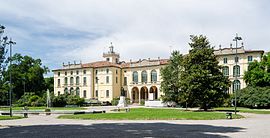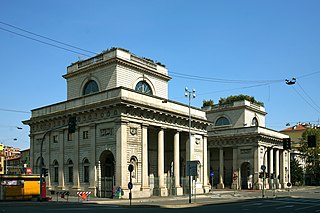
Indro Alessandro Raffaello Schizogene Montanelli was an Italian journalist, historian, and writer. He was one of the fifty World Press Freedom Heroes according to the International Press Institute. A volunteer for the Second Italo-Ethiopian War and an admirer of Benito Mussolini's dictatorship, Montanelli had a change of heart in 1943, and joined the liberal resistance group Giustizia e Libertà but was discovered and arrested along with his wife by Nazi authorities in 1944. Sentenced to death, he was able to flee to Switzerland the day before his scheduled execution by firing squad thanks to a secret service double-agent.

Piazza del Duomo is the main piazza of Milan, Italy. It is named after, and dominated by, Milan Cathedral. The piazza marks the center of the city, both in a geographic sense and because of its importance from an artistic, cultural, and social point of view. Rectangular in shape, with an overall area of 17,000 m2, the piazza includes some of the most important buildings of Milan, as well some of the most prestigious commercial activities, and it is by far the foremost tourist attraction of the city.
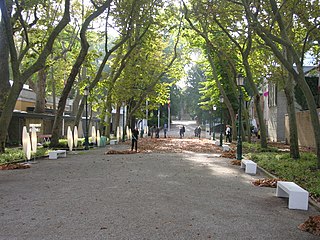
The Venice Giardini or Giardini della Biennale is an area of parkland in the historic city of Venice which hosts the Venice Biennale Art Festival, a major part of the city's cultural Biennale. The gardens were created by Napoleon Bonaparte who drained an area of marshland in order to create a public garden on the banks of the Bacino di San Marco which is a narrow stretch of water dividing the gardens from St. Mark's Square and the Doge's Palace.
Sayaji Baug is a garden located in Vadodara, Gujarat, India. Also known as "Kamati Baug", it was built by Maharaja Sayaji Rao Gaekwad - a great visionary ruler of Baroda. It is the biggest garden in Western India with the area surrounding more than 100 acres (40 ha).
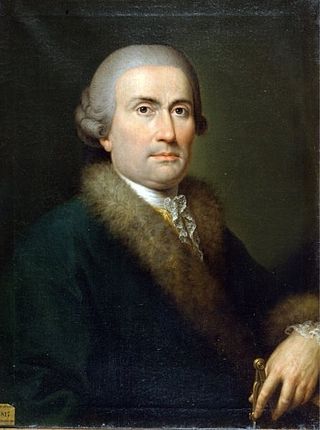
Giuseppe Piermarini was an Italian architect who trained with Luigi Vanvitelli in Naples and designed the Teatro alla Scala in Milan (1776–78), which remains the work by which he is remembered. Indeed, il Piermarini serves as an occasional journalistic synonym for the celebrated opera house. Piermarini was appointed professor in the Academy of Fine Arts of Brera, better known as Brera Academy, Milan, when it was formally founded in 1776.
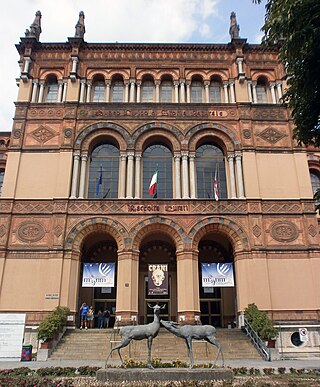
The Museo Civico di Storia Naturale di Milano is a museum in Milan, Italy. It was founded in 1838 when naturalist Giuseppe de Cristoforis donated his collections to the city. Its first director was Giorgio Jan.

Corso Venezia is a street in Milan, Italy. It is one of the city's most exclusive and elegant avenues, being part of the city's upscale Quadrilatero della moda shopping district, along with Via Montenapoleone, Via della Spiga, Via Sant'Andrea and Via Manzoni. It also boasts a great collection of Renaissance, Baroque, Rococo and Neo-classical palaces, parks and gardens.
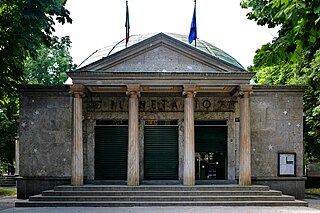
The Milan Planetarium is the largest and most important planetarium in Italy. It is located in the Gardens of Porta Venezia, in the Porta Venezia district of Milan. It was established in 1930, and has been in operation since then.

The Padiglione d'Arte Contemporanea or PAC is a museum of contemporary art in Milan, Italy. It is on via Palestro, next to the Galleria d'Arte Moderna, and across from the Giardini Pubblici Indro Montanelli.

The Zone 1 of Milan, since 2016 officially Municipality 1 of Milan, is one of the 9 administrative divisions of Milan, Italy.

The Galleria d'Arte Moderna is a modern art museum in Milan, in Lombardy in northern Italy. It is housed in the Villa Reale, at Via Palestro 16, opposite the Giardini Pubblici Indro Montanelli. The collection consists largely of Italian and European works from the eighteenth to the twentieth centuries.

The Villa Belgiojoso Bonaparte, also known as Villa Reale and formerly called Villa Comunale, is a palace in Milan, in Lombardy in northern Italy. It was built between 1790 and 1796 as the residence of Count Ludovico Barbiano di Belgiojoso. The villa is in Neoclassical style, and was designed by Leopoldo Pollack. The main entrance is on via Palestro, facing the Giardini Pubblici of Porta Venezia, the eastern gate of the city.

Neoclassical architecture in Milan encompasses the main artistic movement from about 1750 to 1850 in this northern Italian city. From the final years of the reign of Maria Theresa of Austria, through the Napoleonic Kingdom of Italy and the European Restoration, Milan was in the forefront of a strong cultural and economic renaissance in which Neoclassicism was the dominant style, creating in Milan some of the most influential works in this style in Italy and across Europe. Notable developments include construction of the Teatro alla Scala, the restyled Royal Palace, and the Brera institutions including the Academy of Fine Arts, the Braidense Library and the Brera Astronomical Observatory. Neoclassicism also led to the development of monumental city gates, new squares and boulevards, as well as public gardens and private mansions. Latterly, two churches, San Tomaso in Terramara and San Carlo al Corso, were completed in Neoclassical style before the period came to an end in the late 1830s.

The Zone 3 of Milan, since 2016 officially Municipality 3 of Milan, is one of the 9 administrative divisions of Milan, Italy.
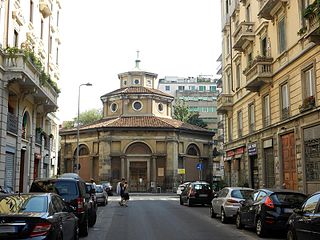
San Carlo al Lazzaretto is a small Renaissance style octagonal church now in largo Bellintani Fra Paolo, number 1 in the quartiere Porta Venezia of Milan. It is located about three blocks northwest of the Porta Venezia. Its present situation, amidst crowded 19th and 20th century apartment blocks, has little relationship to its original placement, in the central park of a massive rectangular cloister-like 15th-century leprosarium (Lazaretto). The church, once called Tempietto di Santa Maria della Sanità or San Carlino, escaped the late-nineteenth century demolition of the Lazzaretto.

The following outline is provided as an overview of and topical guide to Milan:
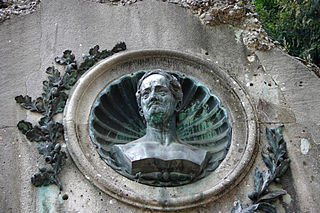
Giuseppe Balzaretto or Balzaretti was an Italian landscape architect and architect.

Palazzo Dugnani or Palazzo Casati Dugnani is a Baroque-style monumental palace located on Via Daniele Marin #2, near Porta Venezia in Milan, region of Lombardy, Italy. The rear of the palace faces the street, while the facade faces the western edge of the Giardini Indro Montanelli. The palace is notable for its salon frescoed by Giovanni Battista Tiepolo.
